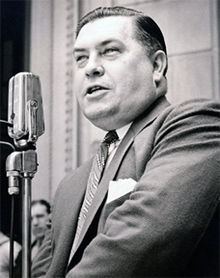Succeeded by A. Harry Moore Religion Methodist Name Harold Hoffman | Spouse Lillie Moss (m. 1919) | |
 | ||
Preceded by Horace Griggs PrallActing Governor Full Name Harold Giles Hoffman Born February 7, 1896South Amboy, New Jersey ( 1896-02-07 ) Movies In the Year 2889, Under Age Similar People Larry Buchanan, Jon Corzine, Chris Christie | ||
Harold Giles Hoffman (February 7, 1896 – June 4, 1954) was an American politician, a Republican who served as the 41st Governor of New Jersey, from 1935 to 1938. He also served two terms representing New Jersey's 3rd congressional district in the United States House of Representatives, from 1927 to 1931.
Contents
Early life
Hoffman was born in South Amboy, New Jersey to Frank Hoffman and Ada Crawford Thom. Ada was the daughter of the painter James Crawford Thom and the granddaughter of Scottish sculptor James Thom. Hoffman also had two ancestors who were soldiers in the American Revolutionary War. His father's side of the family were among some of the early settlers in New Amsterdam, now known as New York City, but originated in Sweden; Hoffman's father's family were the descendents of Dutch nobility.
Hoffman attended public schools and graduated from South Amboy High School in 1913. He worked with a local newspaper until enlisting on July 25, 1917, as a private in the Third Regiment of the New Jersey Infantry. He served overseas in World War I as a captain and advanced to the rank of lieutenant colonel until he was discharged with the rank of colonel in 1946. After World War I, Hoffman returned to South Amboy and became an executive with the South Amboy Trust Company. He later became the bank's president, a position he held until 1942.
Political career
As governor, Hoffman secretly visited convicted Lindbergh kidnapper Bruno Hauptmann in his death row cell on the evening of October 16, 1935, with Anna Bading, a stenographer and fluent speaker of German. Hoffman urged the other members of the New Jersey Court of Errors and Appeals, then the state's highest court, to visit Hauptmann. Despite Governor Hoffman's doubt regarding Hauptmann's guilt, Hoffman was unable to convince the other members of the court to re-examine the case, and Hauptmann was executed on April 3, 1936.
Hoffman was a delegate to the 1936 Republican National Convention.
As governor, Harold Hoffman got into at least two separate fist-fights with reporters. Hoffman's advocacy of a state sales tax cost him the support of his own party, and he was not renominated for a third term as governor.
Due to World War II, Hoffman was granted military leave as director of the Unemployment Compensation Commission on June 15, 1942. He reentered the army as a major in the Transportation Corps and served until June 24, 1946, when he was discharged with the rank of colonel. Upon discharge, Hoffman resumed his position as director of the Unemployment Commission.
In 1948 he appeared on the short-lived ABC network program That Reminds Me.
On February 2, 1950, Hoffman was one of four panelists on the debut presentation of the game show What's My Line?.
Death
On March 18, 1954, Governor Robert B. Meyner uncovered a significant embezzlement scheme perpetrated by Hoffman, and suspended him from his position of Unemployment Compensation Commission Director. Three months later, in June 1954, Hoffman died in a New York City hotel room of a heart attack. Just before dying, the disgraced former governor wrote a confession and admitted that he had embezzled over $300,000 from the state. Hoffman is buried in Christ Church Cemetery in South Amboy, New Jersey.
